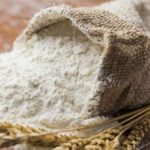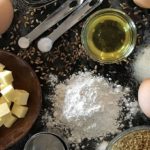Limewater is a fascinating substance that has captured the interest of many. This clear liquid plays a crucial role in traditional Vietnamese confectionery, especially during the festive season leading up to Tet, when families prepare it to create delicious, chewy treats.
1 What is Limewater?

Limewater is created by mixing lime powder with water, resulting in a cloudy white solution. After an hour or two, a fascinating transformation occurs. A layer of scum forms on the surface, sediment settles at the bottom, and in between, you find the prized clear liquid—limewater.
This transparent liquid is the key ingredient for making delicious candies and sweets.
You can either make your own limewater by mixing lime powder with water or purchase it from specialty stores selling confectionery ingredients in traditional markets.
Check out this simple recipe for bánh tẻ
, a soft and fragrant Vietnamese cake that you can easily make at home.
2 The Magic of Limewater in the Kitchen
Limewater is a secret weapon in many traditional Vietnamese confectionery recipes. Here’s how it works:
Limewater for Candy Making:
Some fruits and vegetables used in candy-making, such as bitter gourd, coconut, carrot, and papaya, have a strong odor and bitter taste. Soaking these ingredients in limewater helps reduce the bitterness and odor, resulting in a more pleasant flavor. It also adds a delightful chewy texture to the final product. Without this step, your candies might turn mushy during the cooking process.
Remember to rinse the ingredients thoroughly after soaking them in limewater to avoid any unpleasant aftertaste.

Limewater for Baking:
Limewater is also used to treat ingredients for baked goods, giving them a delightful chewy texture and a beautiful translucent appearance. It’s commonly used in recipes for dishes like steamed cakes, bánh lọt
, bánh ú
, and bánh tẻ
.

3 How to Make Limewater at Home
- Step 1: Mix lime powder with cold water until dissolved.
- Step 2: Let the mixture settle for a few hours.
- Step 3: Use a cloth filter to remove the scum that forms on the surface, and collect the clear liquid for use.
You can make a large batch and store it for future use. Just make sure to keep it in a glass or ceramic container, avoiding metal ones.
4 Important Health Considerations When Using Limewater
When using limewater in your culinary creations, it’s essential to follow the recipe’s instructions carefully. Using too much limewater can affect the taste of your treats and potentially harm your health. Always wear gloves when handling limewater to protect your skin from dryness, cracking, and irritation.
Now that you know the secrets of limewater, you can explore new dimensions of Vietnamese cuisine. Happy cooking, and stay healthy!
For more interesting reads, check out our blog section!
Identifying the Differences between Bleached and Unbleached Flour
This article will take a closer look at the distinguishing features between bleached and unbleached flour. We will examine the advantages and disadvantages of both, so that you can better understand how each type of flour affects baking recipes. Read on to discover more about the unique properties of bleached and unbleached flour!
Essential Tips for Choosing and Using Eggs in Baking
Vân vào khu vực Nấu ăn của Ði?n Máy Xanh để nhận thông tin quan trọng về quy trình bếp để biết làm sao để chọn và sử dụng trứng một cách hiệu quả. Ngoài ra, bạn sẽ tìm hiểu về những lý do quan trọng khi sử dụng trứng trong quá trình nấu ăn. Đừng bỏ lỡ cơ hội này để cập nhật những kiến thức về bếp hiệu quả nhất.



































